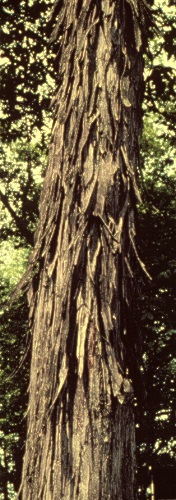Carya ovata
Shagbark Hickory
Juglandaceae
ExpandHabitat
- native to Quebec and southwest to Texas
- zone 4
Habit and Form
- large deciduous tree
- up to 80' tall
- about two-thirds as wide
- very straight central leader
- tree is cylindrical with branches ascending and descending
- coarse texture
Summer Foliage
- alternate leaf arrangement
- odd pinnately compound leafs, up to 14" long
- 5 leaflets, sometimes there are 7
- each leaflet is 4" to 6" long and about 2" wide
- elliptical leaf shape with serrated leaf margins
- leaflets are pubescent when young
- deep yellow-green leaf color
Autumn Foliage
- fall color is yellow to golden
- very attractive
Flowers
- catkins
- not ornamentally important
Fruit
- rounded nut
- 1" to 1.5" in diameter
- thick shell surrounds nut, splits at base when mature
- edible with a sweet taste
Bark
- old bark shags into long plates, generally free at the bottom and attached at the center
- plates are strongly recurved
- gray brown color
Culture
- prefers deep, well-drained soil
- has a large taproot, which makes transplanting difficult
- full sun to partial shade
Landscape Uses
- for fruit
- for unique bark
- naturalized areas
- for barbecues (hickory smoked meat)
Liabilities
- fruit can be a litter problem
- few pest and disease problems
ID Features
- alternate leaf arrangement
- odd pinnately compound leaf with 5 leaflets
- edible round nut
- "shagging" bark
- leaves have apple aroma when crushed
- terminal bud is imbricate with a blunt tip, brown
- terminal bud with 2 to 4 visible pubescent scales
Propagation
- by seed
Cultivars/Varieties
- none










